^zhurnaly 0.9909

Howdy, pilgrim! No ads — you're in volume 0.9909 of the ^zhurnal (that's Russian for "journal") — see ZhurnalyWiki for a Wiki edition of individual items; see Zhurnal and Zhurnaly for quick clues as to what this is all about; see Random for a random page. Briefly, this is the diary of ^z = Mark Zimmermann ... previous volume = 0.9908 ... complete list at bottom of page ... send comments & suggestions to "z (at) his (dot) com" ... click on a title link to go to that item in the ZhurnalyWiki where you can edit or comment on it ...
RSS
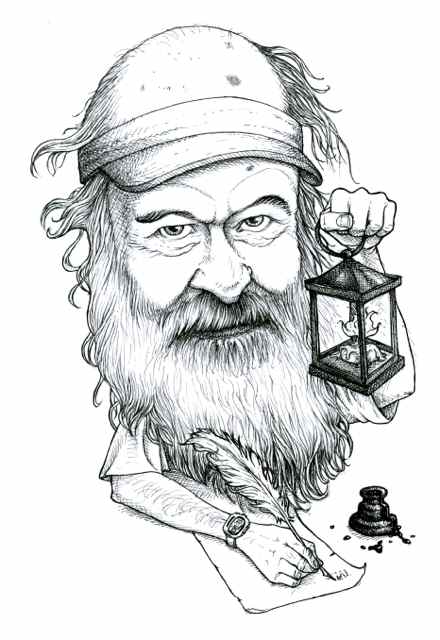 | Gareth Southwell is a philosopher, a writer, and an artist. His drawings in The Philosophers' Magazine caught my eye a few years ago, and when I discovered him online last spring I bought some of his 2013 illustrated calendars as gifts for friends, and asked if he could perhaps draw a caricature of me. The cost was reasonable and I was in no hurry. His sense of self-deprecating humor was also appealing (e.g., his comment, "I'm reluctant to take money up front because it removes my incentive to turn the work around quickly!"). So I sent Gareth links to various online photos of me ([1], [2], [3], [4], [5], [6], etc.) to get him started. Then we brainstormed together on themes that resonate with me — running, Shakespeare, philosophy, mindfulness meditation, tarot, writing, etc. His initial pencil sketch led to further discussions. A water bottle in one hand didn't work too well, so we considered a relay baton, a torch, and eventually a lamp (as in Diogenes looking for an honest man). That led us to a quill pen and inkwell, which after a bit more iteration led to the drawing here. The beard was perhaps the hardest part of this commission, Gareth commented. The big GPS/watch and the visor remain as icons of outdoor activity. I like it!
(click on the image for a higher-resolution version) |
(cf. Gareth Southwell on his main site Woodpig.co.uk, and at Philosophyonline.co.uk, on Twitter, on Facebook, on Amazon.com, ...; cf. TPM at Philosophersnet.com, Philosophypress.co.uk, ...)
- Monday, February 17, 2014 at 04:46:14 (EST)
~3 miles @ ~13 min/mi
After trekking to visit Claire Rubin (2014-01-20 - Mitzvah Run) I rendezvous with Mary Ewell and we circle the NIH campus, with walk breaks and great conversation. Then it's a light gluten-free lunch at the Lilit Cafe in Bethesda, wine shopping advice from Mary, and drive downtown together to see "Yoga: The Art of Transformation" at the Sackler Gallery on the Mall — wonderful fun! (Mary's observations and commentary make her a great companion at an exhibition.) On the way home I walk across the mall and see Marshall Porterfield, Stephanie Fonda, and her daughter Haven at the National Gallery of Art outdoor ice rink. Small world! Runtastic and Garmin hold the data.
- Sunday, February 16, 2014 at 18:25:14 (EST)
~5 miles @ ~9.8 min/mi
Mitzvah Run! Dear family friend Clare (age 94) is out of the hospital and in a nursing home near NIH/Bethesda. It's a great Monday holiday to trot along Rock Creek Trail to visit her. Runtastic and Garmin have the trackfiles. As needed to make the distance a round number, overshoot a bit.
- Sunday, February 16, 2014 at 18:17:36 (EST)
The New York Times review of Martin Gardner's autobiography, Undiluted Hocus-Pocus, by the magician known as Teller, features incredibly lovely images and excerpts:
... Gardner recollects: "I have a strong memory of sitting on a side seat of a subway car, Charlotte on one side and Jimmy, then about 6 months old, sound asleep with his head on my shoulder. People walking by invariably gave us a smile. I thought, 'Here I am, in one of the world's greatest cities, with a woman I love next to me, a son sleeping in my arms. What more could I desire?' It was the happiest moment of my life."
Such moments bejewel the memoir. Gardner remembers the smile of a pretty girl as she looked out of a store window on the streets of Paris, Tex., as the teenage Gardner walked by, too shy to talk to her. He recounts being on a train when his father "pointed out that if you closed your eyes, you could imagine the train speeding the opposite way, or even moving sideways. When sleeping on a train," his father said, "he liked to induce sleep by sending the train in different directions." (Years later Gardner wrote a book on relativity.) Gardner recalls the scent of his wife when he danced with her on the night they met: "It came from her hair and body, and clung to her clothes. If someone had presented me with a dozen dresses worn by a dozen women including Charlotte, I could have easily picked out her dress by its smell." Gardner writes with such frank pleasure, you find yourself surveying your own life for piquant and vivid memories.
"Piquant and vivid memories" indeed — like some of the moments in Tolstoy's War and Peace and other great writing.
(cf. IrresistibleAttraction (2004-10-04), InfiniteSky (2004-10-15), DebutanteDance (2005-03-22), GlobeOfLife (2005-06-25), ...)
- Saturday, February 15, 2014 at 14:05:46 (EST)
~12 miles @ ~11 min/mi
Brrrrr! Saturday Morning breezes chill Rebecca Rosenberg, Barry Smith, and me. From home at 7:15am it's an easy jog to the Bethesda meet-up, then chatty miles along the Capital Crescent Trail. Hot coffee at Così afterwards warms us. I owe RR $$ when she spots an über-cute on-sale set of of nesting matryoshka measuring cups in the window of a craft store, and lends me the money to buy them for DW and/or DD. Runtastic and Garmin record the route.
- Friday, February 14, 2014 at 04:44:33 (EST)
~1.8 miles @ ~9.5 min/mi
Northwestern HS athletic field is locked, and looks too dangerous to sneak into, but at 7:30pm the not-so-pearly gates are wide open at the UM track. After four solo 400m intervals in the gloom an old left gluteus maximus (or is it the gluteus minimus? or just the hamstring?) starts to twinge — and after the 5th repeat it's definitely time to cry "Uncle!" and limp off the oval. Ouch! Lap splits are a brisk 1:43 + 1:41 + 1:41 + 1:41 + 1:45 as a nearly-full moon peeks out briefly, then hides its face. Searchlights dance across low clouds from the direction of the basketball arena, and chill winds gust. See Runtastic and Garmin for data.
- Friday, February 14, 2014 at 04:39:09 (EST)
~23 miles @ ~11.5 min/mi
 | The obelisk occults the sun midway through a breezy Sunday solo loop to downtown DC and back. After the first hour chills come and the windbreaker goes on. The cellphone chirps — comrade Stephanie Fonda checking in from Albany NY — and I immediately trip and fall at mile 19 in Takoma Park. Result: minor scrapes to hands, elbow, knee. The dentist then phones to set up an appointment to replace the temporary crown I broke on a bagel after yesterday's 2014-01-11 - MCRRC Shooting Starr 6k Race Plus. I ponder pausing at the Silver Spring fire station to let a medic look at my bleeding finger, but decide to let them work on more serious injuries. |
| Down 16th St to the White House, where a guard sends runners roundabout barriers at a closed road. Pause to photograph a pair of lovebirds sitting in a tree. Flag-dangling cranes constructing the National Museum of African American History pose in front of the Washington Monument. Take Constitution Av to Union Station, photographing the bizarre-allegorical General Meade Memorial sculpture at 3rd and Pennsylvania Av NW. Refuel, then trek home via the Metropolitan Branch Trail and Georgia Av. Divert slightly in the endgame to add a little bonus distance. GPS track files from Runtastic and Garmin provide details of route and pace. |  |
- Thursday, February 13, 2014 at 11:46:23 (EST)
Chatting with a smart colleague at the office last week, I was startled by how much she was clearly underestimating (and over-criticizing) herself. She thanked me for a small compliment, for relaying the high opinion that other people hold of her work. Maybe the Dunning-Kruger Effect — the tendency of ignorant or less-intelligent people to overestimate their own abilities (see Meta-Ignorance) — has an inverse (or converse, or contrapositive?) side. Super-competent people, at least in my observation, often seem to underestimate their strengths. Maybe it's angst or psychological insecurity? Or a result of over-work by folks whose brilliance has been noticed by others and who, therefore, get assigned more tasks to do? Or do they suffer from a real error of self-evaluation? Are they comparing themselves only to the tiny number of super-super experts, whom they look up to? In the cases I've observed the effect doesn't seem to be feigned self-deprecation or false modesty. Hmmmmm ...
(cf. Illusory Superiority and the Tal Yarkoni 2010 essay on perhaps-related themes, ...)
- Wednesday, February 12, 2014 at 04:28:25 (EST)
Another neat-and-new-to-me word: legumier. In times past I liked to call myself a sous-chef, thinking that it meant something like "junior-assistant-bottle-washer". Alas, according to Wikipedia's current article on the Chef:
The Sous-Chef de Cuisine (under-chef of the kitchen) is the second-in-command and direct assistant of the Chef de Cuisine. This person may be responsible for scheduling the kitchen staff, or substituting when the head chef is off-duty. Also, he or she will fill in for or assist the Chef de Partie (line cook) when needed. This person is accountable for the kitchen's inventory, cleanliness, organization, and the ongoing training of its entire staff. A sous-chef's duties can also include carrying out the head chef's directives, conducting line checks, and overseeing the timely rotation of all food product. ...
That's far too much responsibility for me! And given my vegetarianism, from now on my culinary career goal is to be a mere legumier, who prepares the vegetables. Ethically nicer, mentally less stressful, and with far more headroom!
- Tuesday, February 11, 2014 at 04:16:30 (EST)
~3.6 miles @ ~7.6 min/mi
Huddled masses under the front porch of Sligo Middle School are yearning to run free, before the Montgomery County Road Runners "Shooting Starr" 6k race this cold and damp morning. My shutter clicks at just the right moment to snag Jeanne Larrison Zemarel's camera flash. "I caught the Shooting Star(r)!" she says!
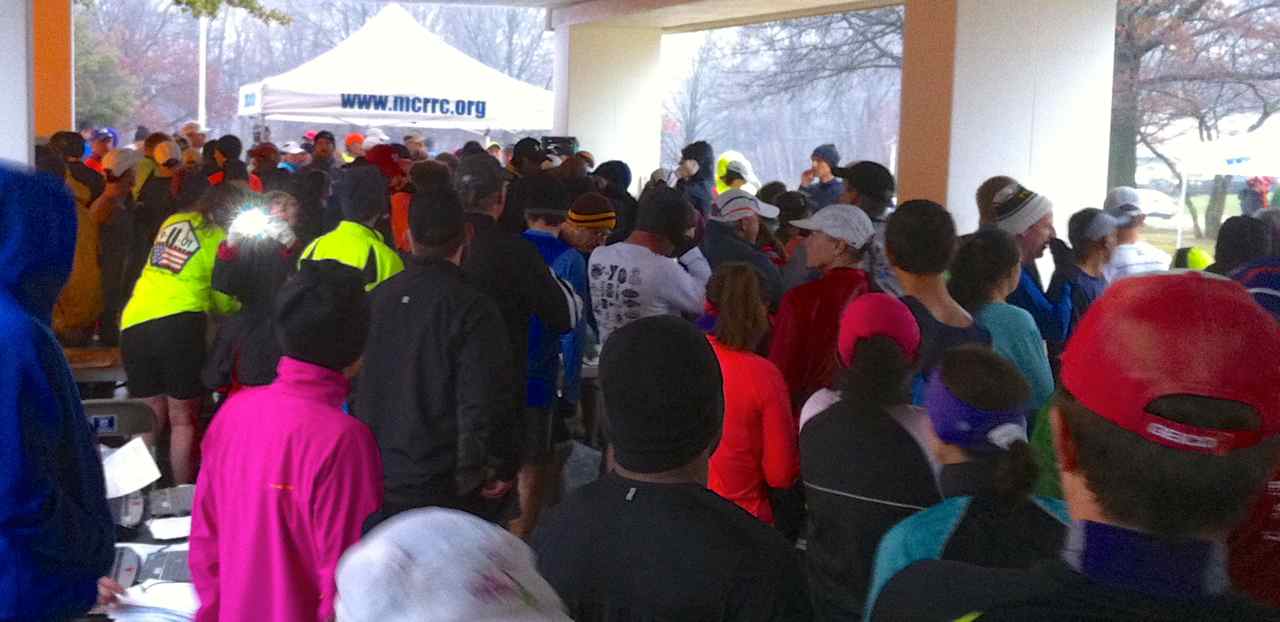
This morning I start from home at ~7:15am in light drizzle and jog the two miles to the school (see track files from Runtastic and Garmin) at ~9.9 min/mi pace, including a pause to tie a wayward shoelace.
The race's start is delayed about 10 minutes to hand the crush of runners and get all the timing equipment ready. Beth Starr, widow of Jim Starr in whose honor the event is held, gives a happy speech of remembrance and gratitude. I strip off my long pants and windbreaker, but mistakenly remove my gloves instead of cap (oops!). The crowded field gradually spreads out, as we leap over icy patches and big puddles along Sligo Creek Trail. Soon my socks are soaking wet. Friend Christina Caravoulias asks for company as I pass during my second lap, her first. So after finishing I put on layers, grab a banana and a cup of orange juice, break my temporary crown on a bagel (ouch!) and head back up the course half a mile to meet Christina and accompany her in to finish.
Official results put me in 82nd place overall, 72nd of 144 men, 4th of 18 in the male 60-64 age group, with a time of 27:25. I'm less than a minute behind my arch-nemesis 7-year-old Jason Parks, and less than a minute ahead of new rival Ian Parsons, age 8. Speedy 15-year-old girl Griffin Myers zips past me in the final fifty feet and I can't quite catch her. My time is 1 second slower than the last time I ran this race, 2011-01-15 - Shooting Starr 6k, three years ago. The GPS records are from Runtastic and Garmin.
Then it's snack a bit more, text friends, and trot home. The ~2 miles return trek goes at ~10.6 min/mi; see Runtastic and Garmin respectively.
- Monday, February 10, 2014 at 04:13:41 (EST)
Although physician-Buddhist Alex Lickerman often writes thoughtfully and engagingly on his blog (cf. Not Marvelous Enough, Smile at Everyone, When Someone You Love Is Unhappy) his 2012 extended collection The Undefeated Mind is rather a disappointment. Maybe it's his unrelenting plugs for Nichiren Buddhism? After logging a score of occurrences — "According to Nichiren Buddhism ...", "Nichiren Buddhism holds ...", "As it's known in Nichiren Buddhism ...", "Nichiren Buddhism teaches ...", "From the Nichiren Buddhist perspective ..." — I stopped counting halfway through the book.
Or maybe it's the anecdotal nature of Lickerman's parables, chapter-by-chapter case studies based on medical patients he has seen over the years, mistakes he has made, and people he has met? Or maybe it's his mystical beliefs and practices? In Chapter 3, for instance, Lickerman recounts from 2002:
In Nichiren Buddhism, practitioners chant Nam-myoho-renge-kyo to acquire the wisdom that enables them to achieve their goals. So I decided I would chant Nam-myoho-renge-kyo one million times ("a one-million-daimoku campaign") to acquire whatever wisdom I needed to find my wife. I'd waged such campaigns several times in the past, so I knew it would take 300 hours, which, given my schedule at the time, meant approximately nine months.
Or maybe it's his subtitle, "On the Science of Constructing an Indestructible Self"? Sorry, but citations at the back of the book to published psychological studies — often poorly designed and based on statistically-invalid samples, one must suspect — don't turn Story into Science. As with Fully Present: The Science, Art, and Practice of Mindfulness by Susan Smalley and Diana Winston, there's really no need to cloak good ideas in the garb of laboratory-tested neurophysiology. Let them stand on their own.
Or maybe it's the whole "unconquerable" and "indestructible" metaphor? Sometimes the Good Guys don't win. That's ok! (cf. Disease as Journey re why the "war" image of cancer is perhaps unproductive)
And yes, setting aside all those off-putting factors, Lickerman offers many good ideas. His chapter titles alone are valuable to ponder:
- The Meaning of Victory
- Find Your Mission
- Make a Vow
- Expect Obstacles
- Stand Alone
- Accept Pain
- Let Go
- Appreciate the Good
- Encourage Others
- Muster Your Courage
No problem with those suggestions!
(cf. Core Buddhism, 01, ...)
- Saturday, February 08, 2014 at 06:00:00 (EST)
~3 miles @ ~10 min/mi
It's spirograph mania on the GPS maps! Starting before 6am, freezing rain and icy streets bring Kristin Heckman and me to our senses after a few steps and near-falls. By the end, half an hour, later one GPS says ~1.8 miles, another reads ~2.3, a third ~3.4 miles. Signals are erratic as we run up and down the levels of two almost-empty parking garages.
And we really achieve the Best of All Possible Worlds: we demonstrate good intentions by starting out to do a heroic soggy-cold neighborhood run, and we demonstrate sensibility by deciding to avoid the ice. If we had done the identical route without attempting to go out on the street, would it have been far less honorable? I tell K about a Daniel Dennett philosophical scenario exploring free will: what if an Evil Scientist is messing with your brain, but only when you decide to do something she disagrees with? Do you really have "free will" when you happen to choose a course of action that doesn't require her to preempt you? In one sense, your "decision" was predetermined by that outside force. Hmmmm ... tough philosophical call, or silly fantasy?
Runtastic and Garmin diverge wildly.
- Thursday, February 06, 2014 at 04:17:19 (EST)
I'm discussing metacognition with a colleague (FNL). At one point he says, "I'll think about that."
To which I reply, "You mean, you'll think about thinking about that!"
(cf. DoMeta (1999-05-08), MetaMan (2001-11-14), ReflectiveStudents (2004-03-17), KeyToTheTreasure (2004-04-23), One Transcend Suffices (2009-10-14), Never Say ... (2011-12-28), ...)
- Tuesday, February 04, 2014 at 18:25:20 (EST)
~3 miles @ ~9.5 min/mi
5°F, 5 km, 5 mi/hr winds, 5:55am Pimmit Hills loop — solo single-digit madness, done just for the sake of an outrageous logbook entry! Runtastic and Garmin GPS concur in the silliness of this venture. The bandana comes untied and slips off my face after a mile, at which point nose and chin become a bit frostier.
- Saturday, February 01, 2014 at 05:33:36 (EST)
~6 miles @ ~10.6 min/mi and ~11 miles @ ~12 min/mi
 | At 7am and ~10°F, a ~6 mile run with Stephanie Fonda along Beach Dr in Rock Creek Park makes for an icy moustache plus beardcicles! A big red-tailed hawk, puffed up against the chill, perches on a branch above the road and eyes us hungrily as we pass below. A cowled figure sings and chants to the rising sun from the pavilion near Military Rd. Anny Rosenthal and others in training groups greet us. Mile splits, including all stops: 12:04 + 10:01 + 11:25 + 10:16 + 10:16 + 9:13 (ha!) The Garmin and Runtastic record details. Two hours later, a veritable heat wave: ~20°F! From home, jog ~3 miles to Candy Cane City, then ~8 miles with Barry Smith & Rebecca Rosenberg along Beach Dr. Snowballs blow down at us from trees. They splatter on the asphalt like inverse Dalmatian spots, white on black. Quote o' the Run by RR: "There's always somebody crazier than you!" Details are at Garmin and Runtastic. |
- Thursday, January 30, 2014 at 04:16:26 (EST)
"An inner journey" is how Patricia Long, our guide, describes the workshop that eight of us are taking this Sunday. Our goal: spend a few hours surveying the landscape of the mind, trying some experiments in relaxation and balance, and maybe (in the words of Joseph Campbell) glimpsing a "sacred place".
So there are poems by Mary Oliver, including "The Ponds", and by the 13th century Sufi mystic Rumi:
Let yourself be silently drawn
by the strange pull
of what you really love.
It will not lead you astray. |
and
Getting doors open
one after the other
is the essence of Prayer.
Every door is a passage,
another boundary we have
to go beyond.
We squeeze ourselves through,
and then we go.
Farther.
... |
And music, both recorded and live. And chanting, "Om Namah Shivaya", to a folk tune accompaniment. And standing in a circle, taking turns mirroring the person beside you, passing spontaneous gestures around the ring.
And most of all, there is sharing. The artist and the Theravada Buddhist computer programmer exchange observations with the international aid worker and the chemist. The musician and the entrepreneur describe what they're feeling to the skeptic and the mother of three young boys. The strength and honesty of the group's experience brings some nearly to tears, scares others, energizes everyone. In Patricia's words, we're being "inspiring, real, authentic, risky."
Or maybe we're just being. Diversity reigns, and it all turns out ok. Among the remarks to remember:
- "When a thought intrudes I just say, 'Oh, well!' and it goes away."
- "At ease, in the moment, right now."
- "It's like coming home, remembering things you forgot."
- "I became aware of my awareness."
There's not a lot of discussion of technique. The space between thoughts gets a bit larger. We sit or lie on the floor, eyes closed or open, attending to breath or sound or texture. It's rather like a series of physical exercises — different in detail but producing the same ultimate results. There's connection, oneness. There's deliberate nonattachment, letting-go, acceptance without judgment. There's a smörgåsbord of methods, as one workshop participant describes it. Some ways work for some people some of the time. It's all good.
Resonances are strong, especially with:
- Meditation Made Easy, Lorin Roche's "buffet" of approaches
- Finding the Quiet and Paul Wilson's taxonomy of meditations:
- deep — inward, narrow, focused, concentrated — absorption, in the yoga or samatha tradition
- directed — intentional, progressive, contemplative, spiritual — communion, in the prayer or tantric tradition
- aware — outward, broad, attentive, nonjudgmental — hyper-consciousness, in the insight or vipassana tradition
- Lunchtime Enlightenment and Pragito Dove's gentle variety of "Meditations to Transform Your Life Now—at Work, at Home, at Play"
- "Notice and Return", Jok Hae's approach to kindly (re)focusing attention
It was ...
(cf. Core Buddhism, 01, Thoughts Drop, ...)
- Tuesday, January 28, 2014 at 05:06:06 (EST)
~3.1 miles @ ~7.4 min/mi and ~7.6 miles @ ~9.5 min/mi
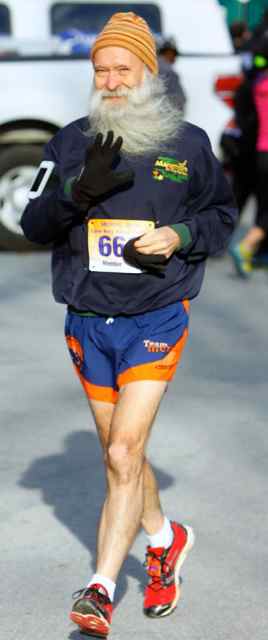 | Brrrrrrrr! Barry Smith kindly drives out to Seneca Creek State Park on a frosty New Year's Day morning for the MCRRC 5k race. Many friends greet us as we hike from parking field to nature center. At bib-and-chip pick-up somebody (I suspect puckish Christina Caravoulias) stacks the deck — I get #666. Yes, the Beast is Back! The blitz begins crowded; it takes almost half a mile of weaving to get by slower folks who were lined up nearer the front. But soon enough there's room to cruise, and pushing hard gives mile splits of roughly 7:21 + 7:19 + 7:28 plus 6:41 min/mi pace for final ~0.1 mile, based on Garmin GPS estimates. The iPhone with Runtastic roughly agrees. Official results say 22:51 gun time; I start 5-10 seconds behind the line. Overall ranking is 3rd of 23 in the 60-64 year old male cohort, 50th of 213 males, and 57th among 421 finishers. Seven-year-old Jason Parks beats me by about 30 seconds, but after finishing I meet eight-year-old Ian Parsons, whom I mistake for Jason and who comes in behind me by about a minute. These two photos are by Dan Reichmann. Where did my hat go between the start and mile 1? Well, as usual legs are warm enough in shorts but there's a bit of wind-chill in, uh, an unmentionable zone ... (^_^) ... (cf. HatBulge) | 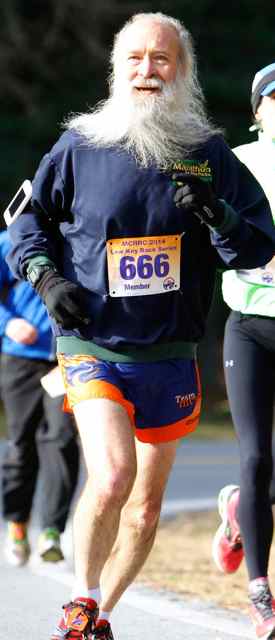 |
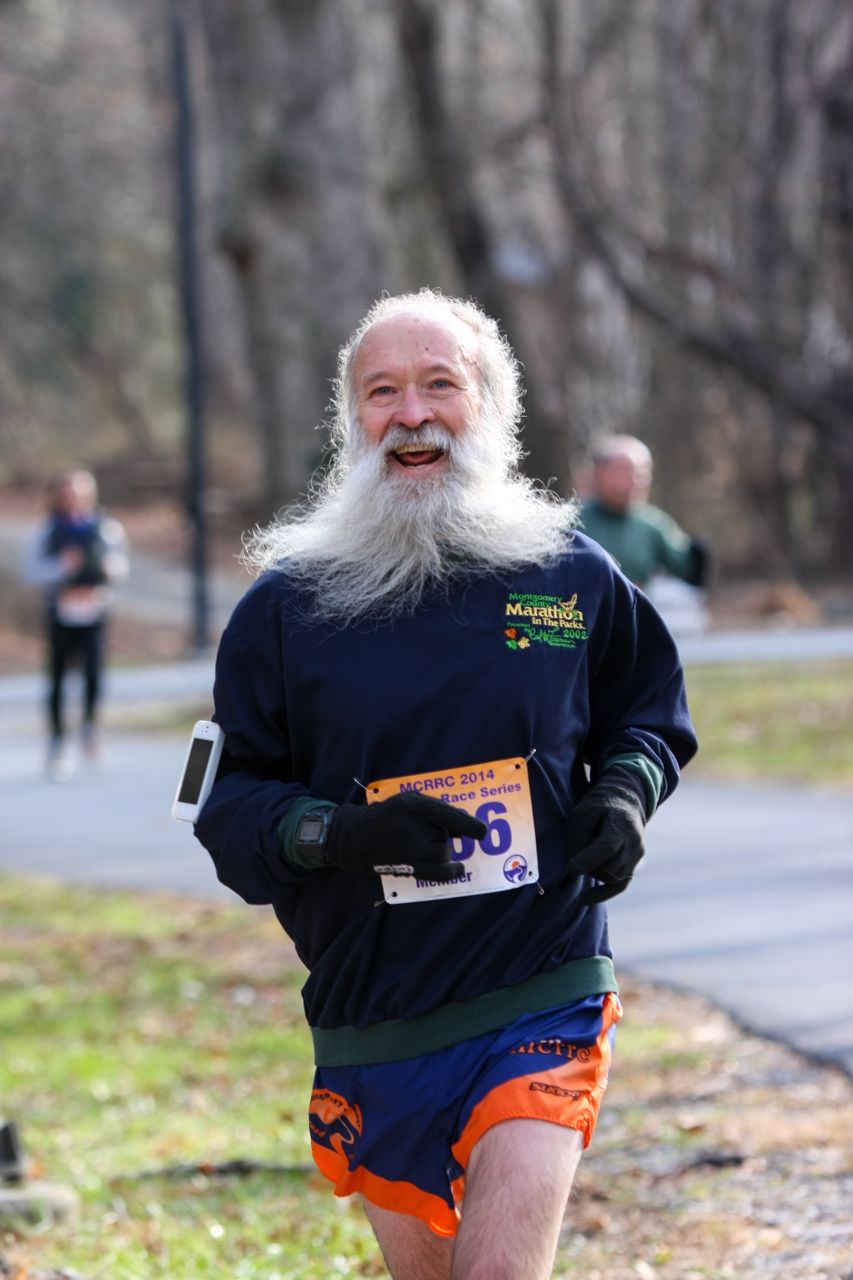 | The photo on the left is by Ken Trombatore, who jokes with me that unlike other recent races, when his camera's battery dies or memory card fills up at my approach, this time he is ready for me! And as usual, he captures a superb image. Several hours later I jog from home to friend Joyce S's in Bethesda for her New Year's Day soirée. I eat far too much inari and too many brownies, and drink too much lemonade-with-ginger. The run home in the deepening evening's gloom is slowed by temporary ocular migraine blind spots that interfere with vision. But all's well, I make it without falling down or colliding with cyclists or dog-walkers. On the way I notice that the street in Joyce's 'hood named "GLADWYNE" is a perfect anagram for my home road, "GWYNDALE". The Garmin GPS estimates mile splits 9:09 + 8:45 + 8:51 before the feast, and 9:19 + 9:25 + 9:15 + 10:21 with 10:00 min/mi pace on the final fraction. Runtastic roughly concurs. |
- Sunday, January 26, 2014 at 06:30:34 (EST)

(an old doorknob, glass sphere selfie)
- Friday, January 24, 2014 at 05:04:06 (EST)
~10 miles @ ~9.7 min/mi
Light rain, big puddles on the sidewalk: it's a solo afternoon jog from home to Union Station along the Metropolitan Branch Trail in DC. There's one functional water fountain at the Takoma Rec Center tennis courts, 3rd & Van Buren Sts NW. The sun only comes out during the ride home on the Metro, when air conditioned cars make for post-run shivers — brrrrr!
Mile splits are 10:40-11:23-9:32-9:42-10:13-10:18-9:06-9:20-8:40-7:42 — pushing on the final flat stretch past the NoMa Station, where a friendly bystander cheers. The Garmin GPS provides the only record of the journey, since sleeping the iPhone before Runtastic finishes its countdown apparently freezes the countdown — oops!
- Thursday, January 23, 2014 at 06:47:44 (EST)
Thoughts drop gently from the mind
Like leaves, like snowflakes,
Toward the heart. |
(inspired by Patricia Long, at a meditation workshop she led on 2014-01-19 in Bethesda, Maryland)
- Wednesday, January 22, 2014 at 04:11:46 (EST)
~17 miles @ ~11.6 min/mi
 | Leaving home at 0715 for an 0800 meet-up at Ken-Gar there's slack in the schedule. Climbing the Mormon Temple hill as the sun creeps above the horizon, when the pink glow starts to hit the golden angel Moroni a must-pause moment looms. As colleague Martin Hyatt says, "This is a building that is hard to go wrong," æsthetically-photographically. So divert into the parking lot, pull iPhone out of plastic bag, open camera, and start snapping. Friendly church-goers smile and nod understandingly as they enter for services. |
| The paved path around the LDS Temple is quiet and offers multiple opportunities to capture different angles. A crescent moon and the contrail of a passing jet line up with the spires. By the time I've circumnavigated the monumental building the ruby glow has transformed into alabaster. Then onward and upward along Stoneybrook Dr to Kent St, across Connecticut Av and through the Ken-Gar neighborhood to the park, mile 7 of Rock Creek Trail. Today's trek along Rock Creek with Barry Smith, Ken Swab, and Rebecca Rosenberg has a mission: we're in search of RR's lost pink cap. Alas, no luck in that quest. Temps are sub-freezing the water fountains are unexpectedly shut down, and I'm not carrying a bottle. Many thanks to Rebecca for kindly sharing her Accelerade! |  |
 | Ken and Rebecca tell a detective story. During their Marathon du Médoc last September, they saw several runners dressed up in chicken-like costumes and carrying UFO-flying-saucer-like props. When asked what they represented, the runners replied, "Super Shoe!" — or something that sounded like that to non-Francophones. After considerable research, Ken reported, finally he solved the mystery: they were saying"soupe aux choux" and referring to the 1981 French comic movie La Soupe aux Choux which means "Cabbage Soup". We run treading on our shadows outbound, four shapes dancing tall on the trail in front of us, as we head toward the new Rock Creek Trail bridge over Veirs Mill Rd. After the turnaround the light pressure is against us and makes the going harder. Or maybe we're getting tired, and it's just uphill there! As we jog along Rebecca asks the rest of us whether we keep records of our runs. Ken does, on paper; Barry has a digital log; and Rebecca already knows about the ZhurnalyWiki's Running Logbook. She remembers incidents when I discover past instances of our conversations in the records. I mention the 1988 "Peewee's Playhouse" Christmas Special, with multiple guest stars including the memorable Grace Jones, who is 65 years old this year. Runtastic and Garmin include the pauses to take photos and to meet up with Barry, Ken, and Rebecca. After we part ways I add a short local ramble to get both the GPS's past 17 miles. |
- Monday, January 20, 2014 at 08:57:51 (EST)
My copy of Embrace Tiger, Return to Mountain — the essence of T'ai Chi sat on the mantle for the past few decades, covered with dust. It had positive vibes, as far as I can recall my first reading of it. But recently upon reopening it, the fuzziness that floated up was overwhelming. The book, according to the Introduction by editor-publishers Barry and John Stevens, is based on transcripts of a week-long 1971 workshop at Esalen led by Al Chung-liang Huang.
Perhaps it was better in person than on paper. Perhaps I've become too critical over the years. Perhaps there is less "there" there than originally met my eye. Unlike the similarly transcript-based Shunryu Suzuki books Zen Mind, Beginner's Mind and Not Always So: Practicing the True Spirit of Zen, the language in Embrace Tiger, Return to Mountain often lacks poetic power.
But there are some striking bits, among the T'ai Chi wave-hands-like-clouds mysticism. From Chapter V, for instance, appears a musing on negative space:
Now raise your arms in front of you and make a circle with your arms by touching the tips of your fingers together. Do you see the empty circle in front of you? This is also a part of your body. Look at the solid circle of your arms. But what about the space in between your arms? Do you negate that? Do you say that's not your body, that it has nothing to do with you? It has everything to do with you. You are enclosing it; it becomes you.
The space between your legs also gives you balance in the t'ai chi base. If you concentrate on the yin space, you relieve your anxiety and the tension in your legs. Then the muscles will relax. Otherwise your thighs may get very tight and sore.
... and after a few paragraphs of describing a particular pose:
With each lift, each transformation of your shape, think of the movement in the space around you. As you lift up, think of your arm and leg resting on the space underneath. Balance must be that mutual cooperation of yin space and yang space. This will relieve you of the anxiety of trying to reach a particular position and then having to hold it. Imagine that the space beneath you pushes you up as you move. As you do this, keep feeling the energy going upwards, between the legs, lifting to the center. Each rebound and kneebend should have that feeling of uplift. Otherwise you feel squat, and pretty soon you will be walking like a duck.
... and in the next chapter of the book, "Calligraphy", the same theme returns during a description of how to prepare to do brushwork:
Now draw an empty circle in space. This is the horizontal t'ui sho circle that we were doing. Now, reverse it and make a loop, an S-shape, an 8-shape, an infinity shape. See if you can continue the loop easily and still maintain that same sense of flow. And then get a little closer to the surface of the paper. Don't touch the paper yet, but just enjoy looking at its nice blankness.
The paper is still completely open and free. This is a good time to think of the distinction between a solid line and a suggested line. Which is more real? When I make a broken stroke, as in painting bamboo, the empty spaces between bamboo become very suggestive of something solid, like the joints of the bamboo. We describe this technique as "brush absent, idea present." We allow the white parts of the paper to suggest sky, snow, water or mist by painting dark areas of earth, mountain and trees. This way of utilizing the original whiteness of the paper corresponds to t'ai chi practice, in which we allow the moving empty space to complement the solid body—the yin and yang.
The yin and yang, the 0 and 1, the negative space between — often so hard to remember ...
(cf. GreatIdeas (1999-05-03), MysticMantra (2005-01-15), Even Odds (2009-05-05), Zen Soup (2012-02-09), Space Between (2013-10-13), 01 (2013-11-05), ...)
- Saturday, January 18, 2014 at 20:20:11 (EST)
Another neat and new-to-me geophysical word: Thalweg, from the German for "Valley Way" — the deepest continuous line in a valley. Besides forming borders between countries or other political entities, thalwegs are often good places to find streams with trails to run along. The "th" in the word is pronounced like a "t".
- Friday, January 17, 2014 at 05:15:40 (EST)
~3 miles @ ~11 min/mi
A chilly crescent moon gleams low in the southwest as Kristin Heckman and I set out on a frosty Friday morning. Puddles are ice-covered. I discuss the chess rating system and learn that Kristin's computer science dissertation was in artificial intelligence, particularly neuro-related processes. We revel in the quiet darkness and marvel at garish Christmas decorations. Garmin shows our route and pace; Runtastic concurs, but I fail to stop it at the end, so it includes half an hour of showering, dressing, and walking to my office.
- Thursday, January 16, 2014 at 04:07:44 (EST)
~1.7 miles @ ~15 min/mi
| Stars twinkle overhead; the temperature has fallen now to near freezing after the past few days of silly warmth. Kristin Heckman leads on the odd-number repeats and I go first on the even-numbered ones, as we descend the eastern staircase and climb the western side 8 times. GPS signal shadows and reflections make for wacky maps. | 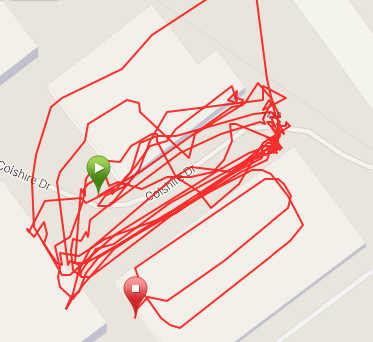 |
| The Garmin is far more consistent on elevation measurement, with its barometric sensor, than the iPhone Runtastic using only GPS. | 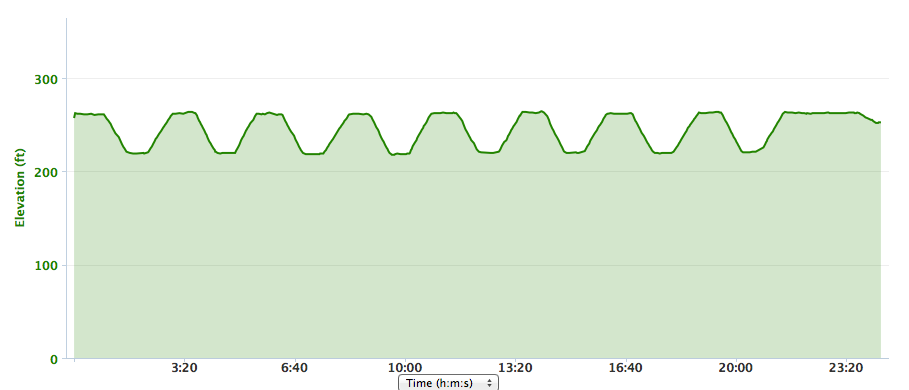 |
- Tuesday, January 14, 2014 at 18:42:01 (EST)
Philosopher Daniel Dennett's 2013 book Intuition Pumps and Other Tools for Thinking is fun and fast, but also rather frustrating. It's mostly a collection of earlier Dennett articles and essays, some revised, as the "Sources" section on pages 445-449 reveals. Perhaps that explains the disjointedness and repetition. The claimed connecting thread among all the chapters, that each one provides a "tool for thinking", is stretched thin and breaks early on. There are plenty of good ideas, metaphors, parables, and thought experiments here, no question. Dennett defines them loosely as "intuition pumps", stories that perhaps provoke and develop one's instincts about an issue. But calling every vague notion about the brain an "intuition pump" weakens that concept beyond usefulness.
Within the recycled prose there are embarrassing glitches — like the repetition of phrases in a discussion of bird vision:
- Chapter 16 (p. 71): The bird tracks insects and must deal with their erratic flight patterns by having a higher flicker-fusion rate (in effect it sees more "frames per second" than we do, and hence a movie would be like a slide show to it).
- Chapter 67 (p. 372): Another is the erratic flight of butterflies, whose trajectories are hard for insectivorous birds to predict, though evolution has helped the birds by giving them a faster "flicker fusion rate" than we have, for instance (they see more "frames per second" than we do—a movie would look like a slide show to them).
But there are fine sections too. For example, Chapter 3 quotes Anatol Rapoport's rules for "successful critical commentary", some excellent suggestions (which Dennett himself immediately admits that he doesn't always follow):
- You should attempt to re-express your target's position so clearly, vividly, and fairly that your target says, "Thanks, I wish I'd thought of putting it that way."
- You should list any points of agreement (especially if they are not matters of general or widespread agreement).
- You should mention anything you have learned from your target.
- Only then are you permitted to say so much as a word of rebuttal or criticism.
And in Chapter 16, Dennett quotes philosopher Wilfrid Sellars's 1962 one-sentence definition, "The aim of philosophy, abstractly formulated, is to understand how things in the broadest possible sense of the term hang together in the broadest possible sense of the term." Maybe that's the key mission—understanding. That's also the major frustration of Intuition Pumps, which often degrades into "talking around" concepts and ideas, piling on plausible words to make persuasive but peripheral arguments that end up not proving the point. Clever concept-slinging, but no conclusions. "Presumably", "could be", "might be", and the like are sprinkled throughout what should be solid reasoning or factual explanation.
Once in a while Dennett admits to this weakness, as in Chapter 32 when he notes, "... the contribution of imagination in the generation of intuitions is harder to control than philosophers have acknowledged." In other words, fallacious logic gets past, cloaked in plausibility. As that same chapter remarks, "Experience teaches, however, that there is no such thing as a thought experiment so clearly presented that no philosopher can misinterpret it ...", and "... the utility of a thought experiment is inversely proportional to the size of its departures from reality ...".
The best bit of Intuition Pumps, though, lies buried in a footnote discussion in Chapter 35, where Dennett points to a 1987 essay by W. V. O. Quine ("Universal Library") which points out that "... you can store the whole Library of Babel in two extremely slender volumes, in one of which is printed a 0 and in the other of which appears a 1!" (Shades of 01!)
(cf. Free Action (2000-04-03), Thoughtful Metaphors (2008-11-08), Freedom Evolves (2003-07-03), Contemporary Introduction to Free Will (2008-06-15), ...)
- Monday, January 13, 2014 at 06:51:03 (EST)
~8 miles @ ~11.4 min/mi
"Splish, Splash, Splosh!" Kristin Heckman tells me about a Thomas the Tank Engine (children's TV show) episode involving puddles, which we reenact this morning in the warm rain. Wet cedar branches hang low and slap me in the face along Magarity Rd. In turn, I explain retro reflective street-sign material and a variety of optical phenomena including earthshine, halos, glories, sun dogs, and aureoles (not areolas!). Runtastic and Garmin generally agree on track data, as we meander starting near 6am in a modified double loop around the Pimmit Hills neighborhood.
- Saturday, January 11, 2014 at 05:53:15 (EST)
~11 miles @ ~10.2 min/mi
Late morning, head out to run between storm squall lines and showers, but come to a dead stop 1/4 mile from home: a freight train blocks the grade crossing. Turn back and try another route? Crawl across the tracks between the cars, like a real fool? As I dither the train begins to creep along slowly, removing the second possibility. Then Mike Kerr appears. He's a friendly-fast young fellow who is new to the neighborhood and has a young daughter. We chat while waiting ~5 minutes for the tracks to clear, discuss local running routes, races, clubs, etc.
Then Mike blasts away and I plod onward, pulling my average pace back down after that delay, which with the GPS units unpaused gives mile splits of 14:22-9:28-9:33-10:08-10:29-9:40-9:50-9:59-9:18-9:35-9:34 and a similar final fractional mile. Lots of other folks are out also today, along Rock Creek Trail, Cedar Lane, the Bethesda Trolley Trail, and the Capital Crescent Trail. Anny Rosenthal is flying down the hill near NIH and pauses to greet me with mock-hugs (hi Anny!). Fog hangs over Rock Creek, as unseasonably warm winter weather continues. The GPS records of Garmin and Runtastic generally concur.
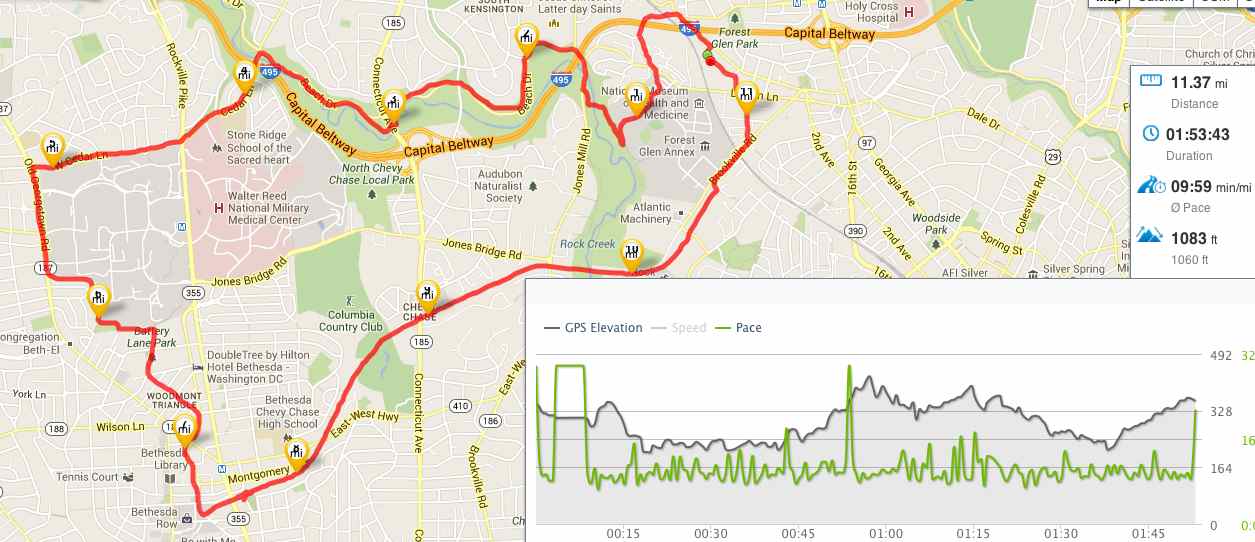
- Friday, January 10, 2014 at 04:21:31 (EST)
From the summary description of the IARPA "Sirius" research project, six major cognitive flaws that minds are subject to, and that tend to cause people to make mistakes in their judgments:
- Confirmation Bias: The tendency to search for or interpret information in a way that confirms one's preconceptions. Often preceded by priming.
- Fundamental Attribution Error: The tendency for people to over-emphasize personality-based explanations for behaviors observed in others while under-emphasizing the role and power of situational influences on the same behavior (also called attribution bias).
- Bias Blind Spot: The tendency for an individual to be unaware of their own cognitive biases, even when the individual can recognize cognitive biases in others.
- Anchoring Bias: The tendency to rely too heavily, or "anchor," on one trait or piece of information when making decisions (related to focalism or focusing illusion).
- Representativeness Bias: The tendency for people to judge the probability or frequency of a hypothesis by considering how much the hypothesis resembles available data. Also sometimes referred to as the "small numbers" bias.
- Projection Bias: The tendency to unconsciously assume that others share one's current emotional states, thoughts and values.
(cf. Wikipedia's list of cognitive biases, ...)
- Thursday, January 09, 2014 at 04:24:11 (EST)
~12 miles @ ~10.5 min/mi
| A classic Chrysler convertable with the top down passes during one of ten LDS Temple hill ascents. The driver smiles and waves. Starting off on this ridiculous warm winter solstice Saturday, with temperatures in the 60's F, it's unclear how many repeats will actually happen. After the first few, however, the old legs settle into a rhythm. Tap a foot on Beach Dr. Climb the slope along Stoneybrook Dr. At Kent St put a hand on the street/stop sign pole and swing around it. Glide back down the hill. Repeat. | 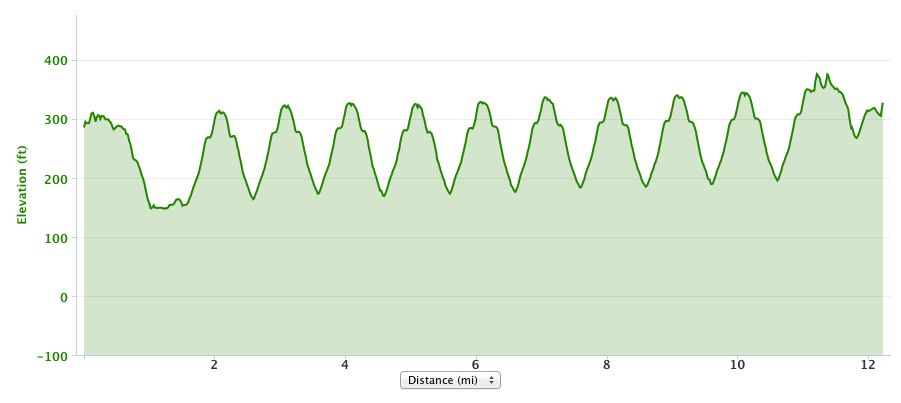 |
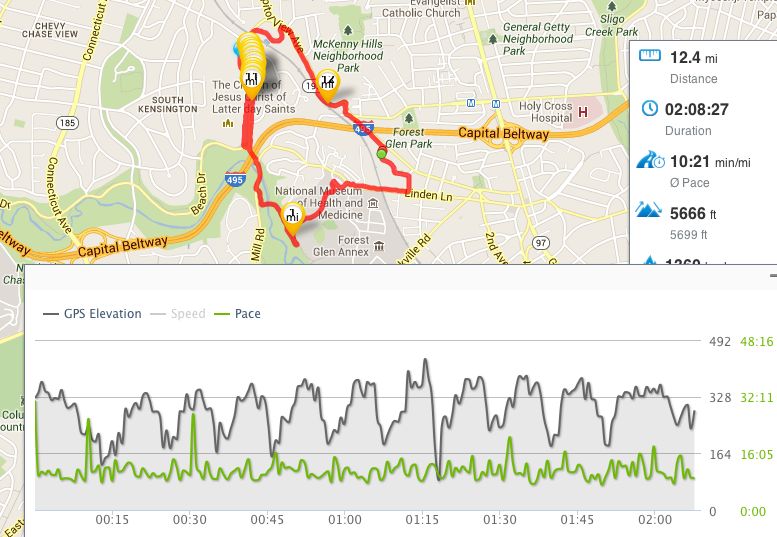 | Runtastic iPhone app and Garmin wrist GPS are in good accord for distance and pace, though the barometric altitude correction for the Garmin provides much more accurate elevation data, as the graphs make evident. |
- Wednesday, January 08, 2014 at 05:03:00 (EST)
From Specimens of the Table Talk of the Late Samuel Taylor Coleridge:
If men could learn from history, what lessons it might teach us! But passion and party blind our eyes, and the light which experience gives is a lantern on the stern, which shines only on the waves behind us!
(December 1831; cf. ImperfectStorm (2001-03-28), ...)
- Tuesday, January 07, 2014 at 04:35:50 (EST)
~10 miles @ ~12 min/mi
Dawn greets us with a beautiful pink sunrise over townhouses and mini-masions as Kristin Heckman and I meander around the Pimmit Hills neighborhood, pause for me to unlock the office for fellow workers, and then continue around McLean. Ice covers the surface of puddles in Lewinsville Park. The Runtastic app using the iPhone GPS provides nicer after-action maps than does Runkeeper. The Garmin concurs on distance and pace, modulo my failure to properly pause during the break. Conversation is wide-ranging and wonderful.
- Monday, January 06, 2014 at 07:42:14 (EST)
Spoiler warning! — read Adventure of the Bayesian Clocks - Part One for background and questions. In brief:
The dashboard clock on your car only shows hours and minutes (not seconds). You know the clock is only accurate to plus or minus a few minutes; likewise, your digital watch is set to within a few minutes of true time. Assume the car's clock and your watch are independent, equally likely to have any error within that range, but both running at the same rate so the difference between them is a constant.
At a random time you observe the car clock and your watch. At the moment that you do the comparison, you see that they display the same time in hours and minutes (HH:MM displays are equal; seconds are not shown).
Question: after that single observation, what is the likely difference in seconds between the clock and the watch?
The answer? Use Bayes Theorem to update your beliefs as new information arrives. As per Introduction to Bayesian Statistics, take the odds Before of each possibility, multiply by the likelihood of seeing what happened in each case, and you get the odds After. For instance, if you have three coins in your pocket — one normal, one double-headed, and one double-tailed — and you take a coin out at random and start tossing it, then every time it comes up "heads" the odds that it's the two-headed coin get multiplied by two, and the odds that it's the two-tailed coin get multiplied by zero.
Now consider the time difference Δ between dashboard clock and watch. Initially all values of Δ are equally likely. The first observation that HH:MM match is 100% sure to occur if the (unseen) value of seconds SS for clock and watch agree; it's 50% likely if Δ = 30 seconds; it's zero chance if Δ > 60 seconds. So the After belief in the time difference goes from being equiprobable to something like a triangle shape, peaked at Δ = 0 and falling linearly as the absolute value of Δ increases. (Hmmm, like the Greek letter Delta = Δ, eh?!)
Wait a random length of time and make another observation of HH:MM. If watch and clock agree, the unknown value of Δ becomes more sharply peaked around 0. What happens if they disagree? What if a long series of random observations shows agreement 50% of the time? Or 1/60th of the time?
And to warm up for the continuous case, suppose you have three watches in your pocket, one perfectly synchronized with the dashboard clock, one set 30 seconds ahead, and one that's 2 minutes off. Take one watch out at random and start comparing its HH:MM display with the clock at randomly separated times. How do the odds change that it is each of the three coins, uh, I mean watches?
(cf. Statistics - A Bayesian Perspective (2010-08-13), Introduction to Bayesian Statistics (2010-11-20), Probability Theory, the Logic of Science (2013-11-18), Statistical Hypothesis Inference Testing (2013-12-01), Adventure of the Bayesian Clocks - Part One (2013-12-04), ...)
- Sunday, January 05, 2014 at 11:47:18 (EST)
~12.4 miles @ ~10.4 min/mi
A big amber caution-light of a full moon rises next to Jupiter at mile 10 of a Wednesday evening run around the Rockville Millennium Trail. DW is at a Library Board meeting. Skaters cruise around the rink at town center where the trek begins. Temps are in the 30's. Pick up the pace in anticipation of a Taco Bell dinner, make the crosswalks safely at the traffic lights, and then ~20 minutes after the run ends: Brrrrrrrrrr! Uncontrollable shivering suddenly starts, as I climb out of the car at the fast food joint. Don a thick parka in a feeble effort to get warm. Garmin and Runkeeper record the route. Splits from Runkeeper: 10:10-10:30-10:26-10:48-11:09-11:22-10:25-9:42-10:00-10:03-9:53-9:45 and 9:43 min/mi on the final fragment.
- Saturday, January 04, 2014 at 05:23:05 (EST)
Work, home, arguments, traffic, ... — a host of things can get heated and overly-busy and high-stress. A thought worth remembering in "Boom Or Bust: 48 Hours At Leadville's Treacherous Ultramarathon", as author Tom Ley interviews a woman at the Leadville 100 miler:
I asked her what it felt like to finish. "It's an amazing accomplishment," she said. "Sometimes I'll find myself sitting in a particularly hectic or stressful meeting and I'll think to myself, 'This is nothing. I've run 100 miles before. I've done something truly amazing.'"
(Ley's essay is dated 2012-12-10; cf. Eric Clifton (2004-10-01), RunningThroughTheWall (2005-01-23), Big Stick (2010-05-18), Shoot the Moon (2011-04-09), 100 Mile Eyes (2013-04-30), PMA at Hardrock 2013 (2013-07-23), Like a Child at the Grownups' Table (2013-11-09), ...)
- Friday, January 03, 2014 at 04:49:24 (EST)
~10 miles @ ~10.2 min/mi
Today's trek is roughly a mirror-image of yesterdays: from the Music Center, head west on University but turn upstream along Northwest Branch Trail; climb out of the valley and, via Oakview, New Hampshire, Adelphi, and Metzerott roads, come back to campus in a big loop. There's some getting-lost and wetting-feet in the brush behind the apartments at University and Metzerott, trying to bushwhack through to Paint Branch Trail, then giving up and taking to the roads again. End when Runkeeper reckons 9.99 miles. The Garmin rolls over to 10.00 before hitting the Stop button.
- Thursday, January 02, 2014 at 04:40:15 (EST)
~11 miles @ ~10 min/mi
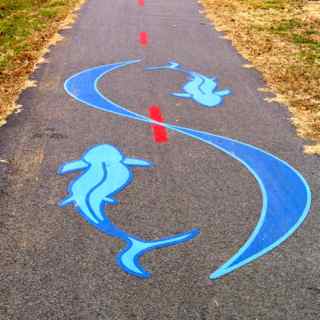 | 'Tis the season for cars to stop suddenly, to avoid hitting Santa in the crosswalks as he is out on a tempo run! Or so one might imagine, given the unusual politeness of drivers today. The old right hamstring has been tight for the past week, and its soreness is slightly exacerbated by yesterday's Tai Chi "accident" (attempting to stand on one foot, I almost topple — must work on balance!). Today's run starts off past the locked-shut gates of the University of Maryland track, where two young guys wave and then proceed to climb the fence. I don't feel spry enough to join them in speedwork, so west it is along University Blvd to Northwest Branch, downstream to the confluence with Northeast Branch, then back up to Paint Branch Trail and Lake Artemesia, and thence closing the loop across campus. |
| At Melrose Skateboard Park on the Northwest Branch Trail in Hyattsville, MD I pause to photograph the captivating yin-yang-curvy decorative images on the asphalt and the three-panel beautiful Hokusai-like mosaic by Valerie Theberge. Runkeeper and Garmin concur on GPS data.rough splits by the Garmin: 10:39 + 10:01 + 9:34 + 9:34 + 9:32 + 12:05 (photo op!) + 9:33 + 9:24 + 9:30 + 9:24 + 9:30 and final fraction at 9:27 min/mi pace. |  |
- Wednesday, January 01, 2014 at 20:18:39 (EST)
A philosophical musing, "What If Our Brains Aren't Good Enough?" from almost two years ago by Buddhist physician Alex Lickerman examines the nature of mind and consciousness. Lickerman asks some key questions about limitations, and in particular wonders whether enlightenment might be a happy illusion, instead of a deep insight into reality:
As far as I can tell, the form of this ultimate knowledge—enlightenment—is principally an emotional state, a sense or a feeling about what the truth is, accompanied by ideas expressible in language that can only ever capture the experience of it incompletely. The sense I have is that to become enlightened is to tap into a completely different way of knowing.
Or maybe not. Enlightenment could be nothing more (though this would be far from nothing!) than a supremely joyful state in which we feel all matter and life contained within the universe are one. Though Buddhism presumes the knowledge and wisdom one can gain from enlightenment actually reflects the truths about the cosmos, the skeptic in me recognizes this to be a first principle—meaning it's unprovable. And the scientist in me recognizes that our brains—again, marvelous as they may be—may actually not be marvelous enough, and that the experience of enlightenment (a life-state that's entirely reasonable to believe is possible given that many have reported experiencing it) doesn't actually describe the way things are, but simply represents the most enviable life-state we can experience.
And in fact, if that's "all" enlightenment is — a pleasing fancy, a cheery delusion of understanding caused by an unusual brain-state — well, that's nothing to scorn, eh? Particularly if it leads one to lead a better life in countless other ways. And even if it's not accompanied by testable predictions about the motions of electrons or galaxies. Maybe being a happier, wiser person is good enough!
(cf. Atheist Spirituality (2009-01-29), Don't Panic (2010-11-17), When Someone You Love Is Unhappy (2011-05-29), Smile at Everyone (2013-02-15), Bodhisattva's Brain (2013-04-20), ...)
- Tuesday, December 31, 2013 at 04:30:20 (EST)
~2.9 miles @ ~11.5 min/mi
Dawn isn't for another hour, but an Iridium satellite almost 500 miles above the earth catches the sun's beams and bounces them down to us at 6:10am. Kristin Heckman and I walk backwards down the street to spy the -6 magnitude glint high in the northern sky. We're out for a chilly loop around the Pimmit Hills neighborhood, braving brisk breezes and temps in the upper 20s. Mostly we stick to the middle of the road, to avoid icy patches on the sidewalks, but we take detours to evade cars as sleepy commuters and school buses zip past. Runkeeper and Garmin concur on distance to better than 1%. Our mile splits by the Garmin nicely descend, 12:11 ⇒ 11:32 ⇒ 10:49 min/mi pace on the final fraction.
- Monday, December 30, 2013 at 04:06:48 (EST)
The classic 1970 movie Little Big Man, a comic-historic-satirical western, is full of brilliant lines that have become household words — at least in this household. Among the best are those said by Faye Dunaway's character, both before and after she gives the protagonist played by Dustin Hoffman a bath:
Highly useful at potentially-embarrassing moments! And then there's the wonderful exchange near the end of the film between Chief Dan George's character and Hoffman's, when the old Chief lies down on a hilltop and wills himself to die. After a while it begins to rain. Eventually the Chief stirs:
"Am I still in this world?"
"Yes, Grandfather."
"I was afraid of that. Well, sometimes the magic works; sometimes it doesn't." |
At which point he gets up and they go back down the hill together, thoroughly soggy, to have dinner.
And indeed, especially as one gets older, sometimes the magic doesn't work ...
- Sunday, December 29, 2013 at 18:51:03 (EST)
~5.5 miles @ ~9.3 min/mi
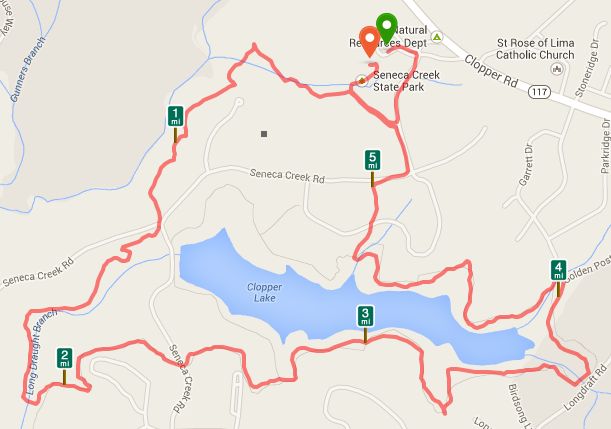 | Brrrrrrr! Snow flurries begin as the Seneca Slopes XC race is about to start. It's a hilly trek through the woods, over rocks, roots, and a few muddy swales. At mile 4 I slip and fall; fellow runners pause to check but I'm ok and wave them on as I stagger to my feet, check knee and hand but only find slight scrapes, pick up my cap, and carry on with a loss of only a few seconds. Arch-nemesis 6-year-old Jason Parks beats me handily today, by more than a minute, as the official results list me first of seven in the 60-64 year old male cohort, 57th place overall behind 48 men and 8 women, with 153 total finishers. The Garmin GPS and iPhone Runkeeper roughly concur on route and pace. |
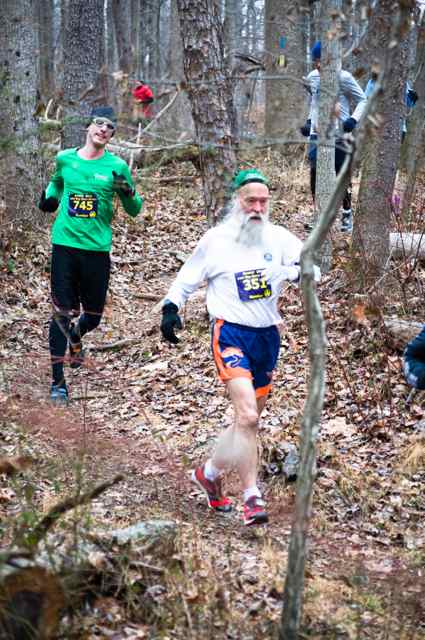 | Approximate splits from the Garmin: 9:01 + 9:18 + 9:42 + 9:34 + 9:18 + final fraction kicking it in at 8:39 min/mi pace. Many thanks to kind friend Barry Smith for driving me to/from the race!
(photos by Hai Nguyen — at mile ~1.5 and climbing the stairs to the finish line)
| 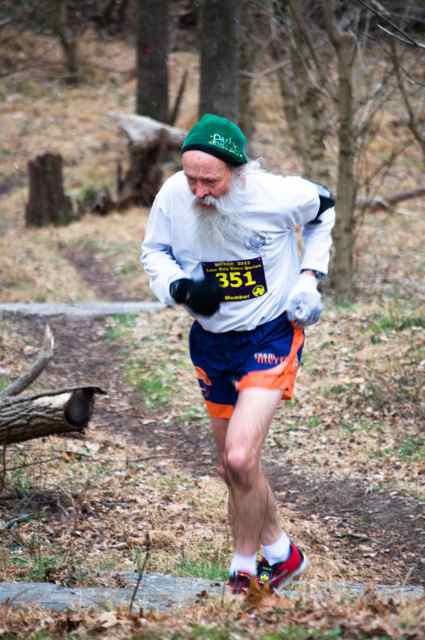 |
- Friday, December 27, 2013 at 04:20:43 (EST)
Quotes on improvisational theatre concepts, from Keith Johnstone workshops on improv a few years ago as shared by actor William Hall :
- "Every time you go the way the audience expects, they'll think you're original. People laugh with pleasure at the obvious."
- "If you do your best, you'll get some form of stage fright. Be obvious. If you believe you're good already, you don't need to do extra stuff to impress us. Your best work comes when you're absorbed, because then your ego is away."
- "We made a mistake. That's good. We just learned something."
- "You may never know what the other person wants. You'll be an expert at saying "yes" — but you'll never know what inspires your partner. Can you please or inspire your partner?"
- "In life, most of us are highly skilled at suppressing action. All the improvisation teacher has to do is to reverse this skill and he creates very 'gifted' improvisers. Bad improvisers block action, often with a high degree of skill. Good improvisers develop action."
(cf. Impro (2012-11-10), Yes, and... (2012-11-14), Positive and Obvious (2012-12-12), Attendance (2012-12-29), Improv Story Rules (2013-01-20), Make Mistakes (2013-02-27), Your First 5000 Mistakes (2013-04-18), ...)
- Thursday, December 26, 2013 at 04:31:17 (EST)
~16 miles @ ~10.7 min/mi
The day begins with brisk solo 10k warmup, rambling from home via 2nd Av and 16th St to North Portal Dr NW, where two deer graze just inside the DC line. Leland St provides solo hillwork before a rendezvous with the gang — Barry Smith, Gayatri Datta, Ken Swab, Rebecca Rosenberg, and Sara Crum — at Candy Cane City. We trot down Rock Creek ~6 miles to Broad Branch Rd, then return. Friendly Vee Hartenstein greets us near Military Rd, halfway through a long run from her Rosslyn home. Post-trek breakfast with Gayatri & Barry & Rebecca & Ken is at the famous Parkway Deli, payoff from loser to winner of a fantasy football game. Garmin and Runkeeper differ by ~3% overall.
- Wednesday, December 25, 2013 at 16:05:13 (EST)
Buck and doe, grazing in DW Paulette's back yard garden last week:
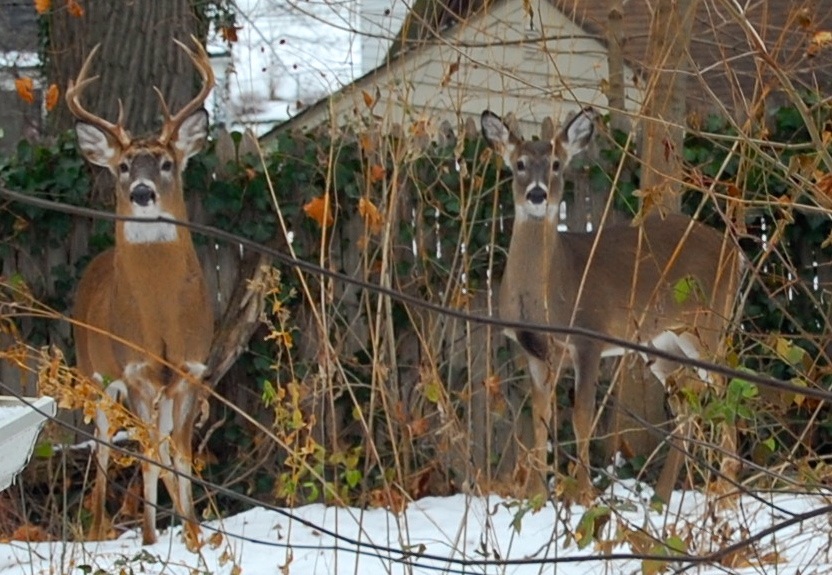
The four-point stag himself:

(for other local deer cf. 2007-06-02 - Lost and Fawn, SummerShambles (2007-07-17), PiedBeauty (2007-08-27), 2012-11-11 - Sligo-Randolph-Rock Creek Loop, ...)
- Tuesday, December 24, 2013 at 04:12:17 (EST)
~6 miles @ ~11.1 min/mi
As we start, the car thermometer registers a brisk 27°F — it's a balmy 29 when we stop. Barry Smith, Rebecca Rosenberg, and Ken Swab lead me limping (tight right hamstring after yesterday's race) along Rock Creek Trail, with a digression to Ken-Gar for hillwork. Four big deer stare at us along the way. RacePacket sets up for a frigid 5k, and we pose by the clock at the finish line. Garmin and Runkeeper show time and distance trackfiles.
- Monday, December 23, 2013 at 04:11:09 (EST)
Happiness isn't the only thing in life — but it is, or perhaps should be, an indicator that one is on a good path. Recently a friend pointed out an essay/post by Belle Beth Cooper, "10 Simple Things You Can Do Today That Will Make You Happier, Backed By Science" that offers a neat list:
- Exercise more — 7 minutes might be enough
- Sleep more — you'll be less sensitive to negative emotions
- Move closer to work — a short commute is worth more than a big house
- Spend time with friends and family — don't regret it on your deathbed
- Go outside — happiness is maximized at 13.9°C
- Help others — 100 hours a year is the magical number
- Practice smiling — it can alleviate pain
- Plan a trip — but don't take one
- Meditate — rewire your brain for happiness
- Practice gratitude — increase both happiness and life satisfaction
Good suggestions, though the pseudo-scientific false precision is distracting, unless it's meant to be humorous (unclear if so). Even better: Cooper's blog led to a thoughtful "About Us" page for her company, Buffer, which makes a scheduler program for delayed posting of social media items. The company philosophy and values as stated there is brilliant:
1. Always Choose Positivity and Happiness
You always approach things in a positive and optimistic way
You never criticize or condemn team members or users
You never complain
You let the other person save face, even if they are clearly wrong
You are deliberate about giving genuine appreciation
2. Default to Transparency
You take pride in opportunities to share our beliefs, failures, strengths and decisions
You use transparency as a tool to help others
You always state your thoughts immediately and with honesty
You share early in the decision process to avoid "big revelations"
3. Have a Focus on Self Improvement
You are conscious of your current level of productivity and happiness, and make continual changes to grow
You have a higher expectation of yourself than Buffer does of you
You regularly and deliberately do things that make you feel uncomfortable
You practice activites and develop habits that will improve your mind and body
4. Be a "no-ego" Doer
You don't attach your personal self to ideas
You let others have your best ideas
You approach new ideas thinking "what can we do right now?"
You are humble
You always ship code the moment it is better than what is live on our site — no matter what
5. Listen First, Then Listen More
You seek first to understand, then to be understood
You focus on listening rather than responding
You take the approach that everything is a hypothesis and you could be wrong
You are suggestive rather than instructive, replacing phrases such as 'certainly', 'undoubtedly', etc with 'perhaps', 'I think', 'my intuition right now'
6. Have a Bias Towards Clarity
You talk, code, design and write in a clear way instead of being clever
You over-communicate, repeating things more times than you would intuitively
You use more words to explain, even if it feels obvious already
You don't make assumptions, you instead ask that extra question to have the full picture
7. Make Time to Reflect
You deliberately find time for reflection, because that's where your life-changing adjustments come from
You have a calm approach to discussions and ponder points in your own time
You find time to jump out of the trenches into the higher level thinking that will move the needle
You understand the value of patience and treat it as a muscle which needs practice to grow
8. Live Smarter, Not Harder
You value waking up fresh over working that extra hour
You always aim to be fully engaged in an activity, or resting
You single task your way through the day
You are at the top of your game, as you focus on expanding capacity of your mental, physical, emotional and spiritual energy
You choose to be at the single place on Earth where you are the happiest, and most productive, and you are not afraid to find out where that is
9. Show Gratitude
You regularly stop and are grateful for your circumstances
You are grateful for the work co-workers do to push the company forward and help you move faster
You approach customer conversations with humility and the knowledge that it's a privilege to serve these people
You have gratitude for platforms, tools and open source that laid the foundation for the possibility of the company: "If I have seen further it is by standing on the shoulders of giants" — Isaac Newton
Wisdom!
(cf. Optimist Creed (1999-04-16), How to Win Friends and Influence People (2008-05-17), Pursuit of Happiness (2008-11-19), Let Others Be Right (2012-12-31), ...)
- Sunday, December 22, 2013 at 15:11:44 (EST)
10 miles @ ~7.9 min/mi
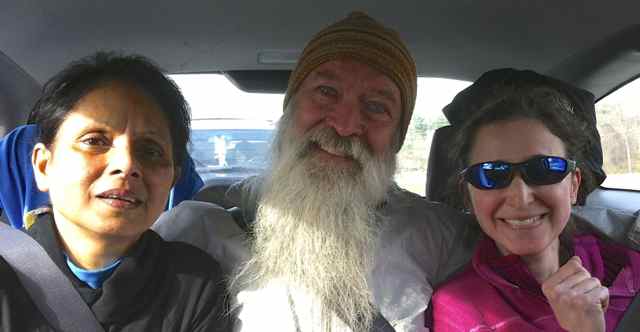 | At the MCRRC Turkey Burn-Off 10 miler I'm Hilary Swab Gawrilow's rabbit for the first few miles, until she pulls ahead to beat me by more than a minute. The weather is brisk, near-freezing. Barry Smith and his daughter Natalie Sayth kindly pick me up, then get Rebecca Rosenberg and Gayatri Datta. We carpool cozy to Seneca Creek State Park. Ken Swab, Don Libes, and Emaad Burki are also racing today. The Garmin trackfile shows slightly sub-8 min/mi average pace. I can't get Runkeeper to start with cold fingers through the plastic shoulder holster holding the iPhone. Approximate splits: 7:37 + 7:51 + 7:52 + 7:44 + 8:13 + 7:42 + 8:00 + 8:10 + 7:38 + 8:04. |
| Official MCRRC race results have me in 84th place overall among 245 finishers, 67th of 141 males, 3rd of 10 in the male 60-64 year group, with chip time 1:18:52 and gun time 1:19:11. Six year old Jason Parks passes me in the final mile and finishes 8 seconds ahead on gun time, but since I started 17 seconds farther back in the crowd I come out in front of him by 9 seconds chip time. Hilary begins the race with me and zooms ahead about mile 4 when I pause at a water stop. Kerry Shepherd introduces herself to me about mile 6. She comments about all the folks who greet me as we go, and I tell her, "It's just because I look weird!" To prove the point, one oncoming fast runner compliments me, "Great beard part!" since as I run along the chin hair tends to divide in two from the wind, as shown in photos when I haven't combed it down with my fingers. | 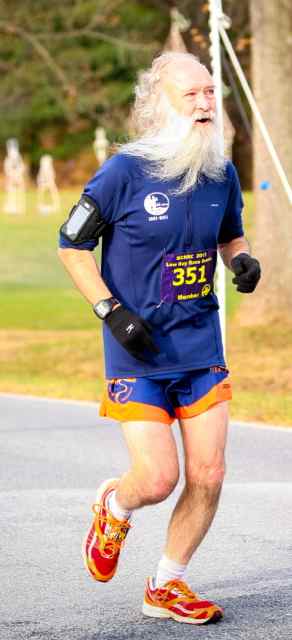 |
- Friday, December 20, 2013 at 04:19:55 (EST)
Friend Dana B some months ago, while putting off more important work, alerted me to the essay "Structured Procrastination" by Stanford philosopher John Perry. His original essay, "How to Procrastinate and Still Get Things Done" appeared in the Chronicle of Higher Education in 1996; a somewhat-revised version is currently on structuredprocrastination.com. It's a marvel of Mark Twainish or Jerome K. Jeromian self-deprecation and begins:
I have been intending to write this essay for months. Why am I finally doing it? Because I finally found some uncommitted time? Wrong. I have papers to grade, textbook orders to fill out, an NSF proposal to referee, dissertation drafts to read. I am working on this essay as a way of not doing all of those things. This is the essence of what I call structured procrastination, an amazing strategy I have discovered that converts procrastinators into effective human beings, respected and admired for all that they can accomplish and the good use they make of time. All procrastinators put off things they have to do. Structured procrastination is the art of making this bad trait work for you. The key idea is that procrastinating does not mean doing absolutely nothing. Procrastinators seldom do absolutely nothing; they do marginally useful things, like gardening or sharpening pencils or making a diagram of how they will reorganize their files when they get around to it. Why does the procrastinator do these things? Because they are a way of not doing something more important. If all the procrastinator had left to do was to sharpen some pencils, no force on earth could get him do it. However, the procrastinator can be motivated to do difficult, timely and important tasks, as long as these tasks are a way of not doing something more important. ...
And obviously: selecting, composing, editing, and posting ^zhurnaly entries is a massive multi-decade exercise in deferring more important but slightly-more-unpleasant tasks. I would expand upon this, but I must first locate some cross-references to add below ...
(cf. Three Man Boat (2002-01-10), LightningRods (2003-11-15), How to Do Things Right (2009-06-03), Earworms (2009-06-09), Tramp Abroad (2010-01-30), ...)
- Thursday, December 19, 2013 at 04:33:30 (EST)
"Following the Breath" is a millennia-old method for mindfulness meditation. ("Anapanasati") Some just relax and attend to the breathing; some count out-breaths, numbering them 1 through 10, over and over again; some count both inhales and exhales; some just maintain an awareness of the air going in and out through the nostrils, or the belly rising and falling. If the mind wanders and you suddenly realize you've lost count, join the club and calmly start over again, without blame or self-criticism. No Worries, Mate!
Recently I've been experimenting with another way to count breaths and maintain awareness: counting down to zero. It has some attractions, not the least of which is the opportunity for entertaining and perhaps-useful mental calming. In brief: start with a nice small number like 6 (which happens to be the first perfect number for those who are mathematically inclined). Count the first exhalation as "6", the next as "5", then "4", and "3", and "2", and "1", and finally "0". Then start the count again, but one less, at "5". Proceed again, 4-3-2-1-0. Then do 3-2-1-0, then 2-1-0, then 1-0, and finally just count 0.
That procedure, counting down from six to zero, then five to zero, etc. adds up to 28 breaths (and 28 is the second perfect number, an amusing coincidence). It takes five minutes or so if you're breathing slowly. You can repeat it, or just settle in with "0" and enjoy trying to increase the space between thoughts. You can visualize an image or sound for each number, perhaps a geometric shape or the tone of a gong being struck. The lower numbers in particular seem to have fruitful associations: 2 can be a yin-yang symbol or other duality; 1 can bring to mind a unison chord or an all-encompassing light; 0 can be a Zen circle, or a void of sheer nothingness.
In fact, the countdown-breathing process of simply, slowly, settling-down on 0 is a fascinating opportunity to empty the mind. Sometimes I try not even saying the word "zero" to myself, and just enjoy the quiet when I get there. Om!
(cf. Being with Your Breath, Breath and Awareness, Breath as Vehicle, Calm Technique, Carpe Spiram, Coming Back to Your Breath, Just Sitting, Mind Over Exercise, Try It for a Few Years, ...)
- Wednesday, December 18, 2013 at 04:51:41 (EST)
~8 miles @ ~12 min/mi
| Once the turkey is in the oven this Thanksgiving morning, there's plenty of time to trot — so to Gayatri Datta's home I drive, and join her for an out-and-back neighborhood trek: leaping across icy-frozen puddles, waving at Bethesda turkey-trot runners, dodging cars, and pausing to pick up yellow golf balls. At the end my nose is crimson from the cold. Runkeeper and Garmin concur on distance and route. | 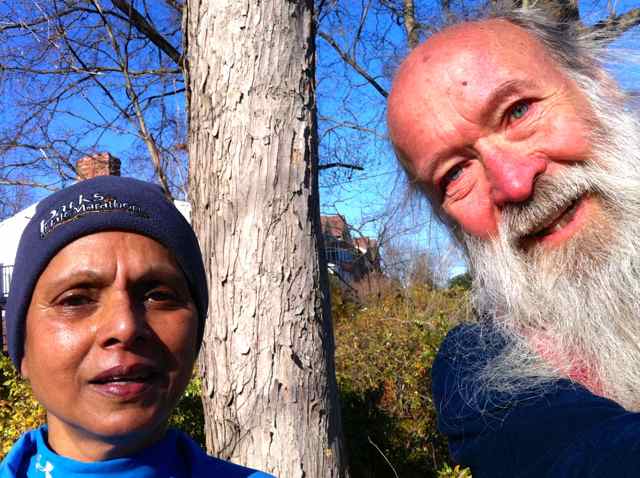 |
- Tuesday, December 17, 2013 at 04:06:29 (EST)
Half a dozen years ago, runner-friend Pete Darmody explained the word "foamer" — a somewhat-derogatory term for a train enthusiast, aka railfan. Another such term just came up in a Washington Post article yesterday, "In Britain, bird-watching gone wild": "twitcher". A twitcher is a hyperactive birdwatcher, obsessed to the point of traveling long distances at the drop of a hat to witness a rare species and check it off on a list of observations. Wikipedia offers a "Twitchers' vocabulary" list of associated terms, including megaticks, chooks, crippler, jizz, and other odd usages.
New words are such fun!
(for a few other semi-random and new-to-me fascinating appellations see: agnize, déhanchement, diaresis, disarticulated, kenosis, kvell, plangent, postalveolar, shul, snuggery, treva, ...)
- Monday, December 16, 2013 at 04:34:00 (EST)
~8 miles @ ~11.4 min/mi
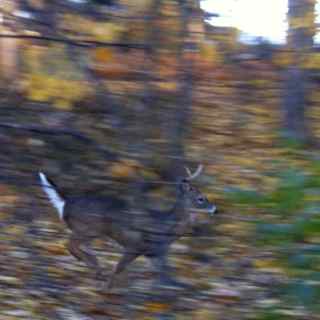 | Two big bucks amble through the woods on a frigid-blustery Sunday morning. As Barry Smith and I approach, the stags race across a tributary stream of Sligo Creek to escape. Temps are in the mid-20s and wind gusts in the 30s, making for chill index in the teens and watery eyes — brrrrrr! My zig-zag path home explores old neighborhood streets just inside the Beltway to add a bit of mileage. Runkeeper and Garmin record the route. |
- Sunday, December 15, 2013 at 07:30:51 (EST)
Carolyn Hax in her Washington Post column on 12 Dec 2013 discusses what she means by one's "Best Self", and how to work on achieving it — a thoughtful take on self-actualization and being a better person. For "cultivating strength" she recommends asking oneself, among other things:
Are you doing things that are meaningful to you; well-suited to your interests, skills and talents; and challenging enough to keep you humble?
Are you with people to whom you want to be kind; who reinforce your good choices; and who don't inspire persistent doubts about whether they're dependable, genuinely fond of you, free of ulterior motives, honest with you?
Are you that person to those you love?
Do you take responsibility for your choices and their consequences?
Do you honor your promises and commitments, to yourself and others?
When you are impressed by, grateful to or concerned about someone, do you show it?
Do you forgive?
Are you representing yourself honestly, to yourself and others, creating no facades to maintain?
Do you take care of yourself — in small ways like flossing and in big ways like thinking through potential consequences before you act? And do you put yourself first in ways that sustain you, to minimize your burdening of others?
Then Hax goes on to discuss how to "tame weaknesses", by developing awareness of one's flaws and working to fix them. Good advice, rather reminiscent of Arnold Bennett's comments on How to Make the Best of Life, as well as elements of Rick Hanson's Just One Thing.
- Saturday, December 14, 2013 at 21:04:27 (EST)
~10.7 miles @ ~8.8 min/mi
 | Fueled by a cup of coffee at sunrise and a stale nacho cheese tortilla chip found on the floor of the car, and with no water en route, it's an experimental fasting-trek following Marshall Porterfield's and Stephanie Fonda's example. Fortunately the day is cool and there's no major problem with dehydration. Lake Artemesia + Indian Creek + Paint Branch trails on Saturday afternoon are thick with cyclists and strollers. Tailgate parties on the University of Maryland campus cheer as I trot past — is my eye-searing orange shirt the color of some visiting team? A flock of crows takes wing at my approach. Runkeeper records the route, since the Garmin GPS is out of power; apparently I left it turned on when I stored it after downloading data the other day. Oooooopsie! |
- Friday, December 13, 2013 at 04:15:02 (EST)
The computer science book Design Patterns: Elements of Reusable Object-Oriented Software (by Erich Gamma, Richard Helm, Ralph Johnson, and John Vlissides) has a flock of thoughtful suggestions about how to solve complex problems, starting with:
One thing expert designers know not to do is solve every problem from first principles. Rather, they reuse solutions that have worked for them in the past. When they find a good solution, they use it again and again. Such experience is part of what makes them experts. ...
Specifically, the authors identify four key elements of a useful design pattern. Quoting from Section 1.1:
- The pattern name is a handle we can use to describe a design problem, its solutions, and consequences in a word or two. Naming a pattern immediately increases our design vocabulary. It lets us design at a higher level of abstraction. Having a vocabulary for patterns lets us talk about them with our colleagues, in our documentation, and even to ourselves. It makes it easier to think about designs and to communicate them and their trade-offs to others. ...
- The problem describes when to apply the pattern. It explains the problem and its context. ...
- The solution describes the elements that make up the design, their relationships, responsibilities, and collaborations. ...
- The consequences are the results and trade-offs of applying the pattern. Though consequences are often unvoiced when we describe design decisions, they are critical for evaluating design alternatives and for understanding the costs and benefits of applying the pattern. ...
In the final "Conclusion" chapter of Design Patterns the authors talk about "The Pattern Community" and the roots of their work, in architecture, from the book A Pattern Language by Christopher Alexander et al. The metaphor of pattern languages, likely, has value in many domains.
(cf. CommonCompSciSense (2002-12-08), ...)
- Thursday, December 12, 2013 at 04:20:56 (EST)
~3.3 miles @ ~9.6 min/mi
Sunday evening, time to test the feet after yesterday's 2013-11-16 - MCRRC Stone Mill 50 Mile Race — set off fast, then pause to photograph a crepuscular buck by Forsythe Av just inside the Beltway near Rock Creek. Press the pace up the Mormon Temple hill along Stonybrook St, and head home via Capitol View, trotting along the narrow shoulder and fearing cars. Splits by Garmin GPS (which records a more conservative 3.32 mi than Runkeeper) are 9:07 (downhill warmup) + 11:21 (deer photos and Mormon Temple hill climb) + 9:37 (making up time downhill again) + final fragment at 9:11 min/mi pace.
- Wednesday, December 11, 2013 at 04:08:07 (EST)
An aphorism widely attributed to Arthur Schopenhauer (1788-1860), which he almost surely never said (in German or otherwise): "All truth passes through three stages. First, it is ridiculed. Second, it is violently opposed. Third, it is accepted as being self-evident."
Yes, and so: "All famous quotations pass through three stages. First, they are garbled or concocted. Second, they are widely repeated. Third, they are debunked."
And no, I never said that!
- Tuesday, December 10, 2013 at 05:02:17 (EST)
For back issues of the ^zhurnal see Volumes
v.01 (April-May 1999),
v.02 (May-July 1999),
v.03 (July-September 1999),
v.04 (September-November 1999),
v.05 (November 1999 - January 2000),
v.06 (January-March 2000),
v.07 (March-May 2000),
v.08 (May-June 2000),
v.09 (June-July 2000),
v.10 (August-October 2000),
v.11 (October-December 2000),
v.12 (December 2000 - February 2001),
v.13 (February-April 2001),
v.14 (April-June 2001),
0.15 (June-August 2001),
0.16 (August-September 2001),
0.17 (September-November 2001),
0.18 (November-December 2001),
0.19 (December 2001 - February 2002),
0.20 (February-April 2002),
0.21 (April-May 2002),
0.22 (May-July 2002),
0.23 (July-September 2002),
0.24 (September-October 2002),
0.25 (October-November 2002),
0.26 (November 2002 - January 2003),
0.27 (January-February 2003),
0.28 (February-April 2003),
0.29 (April-June 2003),
0.30 (June-July 2003),
0.31 (July-September 2003),
0.32 (September-October 2003),
0.33 (October-November 2003),
0.34 (November 2003 - January 2004),
0.35 (January-February 2004),
0.36 (February-March 2004),
0.37 (March-April 2004),
0.38 (April-June 2004),
0.39 (June-July 2004),
0.40 (July-August 2004),
0.41 (August-September 2004),
0.42 (September-November 2004),
0.43 (November-December 2004),
0.44 (December 2004 - February 2005),
0.45 (February-March 2005),
0.46 (March-May 2005),
0.47 (May-June 2005),
0.48 (June-August 2005),
0.49 (August-September 2005),
0.50 (September-November 2005),
0.51 (November 2005 - January 2006),
0.52 (January-February 2006),
0.53 (February-April 2006),
0.54 (April-June 2006),
0.55 (June-July 2006),
0.56 (July-September 2006),
0.57 (September-November 2006),
0.58 (November-December 2006),
0.59 (December 2006 - February 2007),
0.60 (February-May 2007),
0.61 (April-May 2007),
0.62 (May-July 2007),
0.63 (July-September 2007),
0.64 (September-November 2007),
0.65 (November 2007 - January 2008),
0.66 (January-March 2008),
0.67 (March-April 2008),
0.68 (April-June 2008),
0.69 (July-August 2008),
0.70 (August-September 2008),
0.71 (September-October 2008),
0.72 (October-November 2008),
0.73 (November 2008 - January 2009),
0.74 (January-February 2009),
0.75 (February-April 2009),
0.76 (April-June 2009),
0.77 (June-August 2009),
0.78 (August-September 2009),
0.79 (September-November 2009),
0.80 (November-December 2009),
0.81 (December 2009 - February 2010),
0.82 (February-April 2010),
0.83 (April-May 2010),
0.84 (May-July 2010),
0.85 (July-September 2010),
0.86 (September-October 2010),
0.87 (October-December 2010),
0.88 (December 2010 - February 2011),
0.89 (February-April 2011),
0.90 (April-June 2011),
0.91 (June-August 2011),
0.92 (August-October 2011),
0.93 (October-December 2011),
0.94 (December 2011-January 2012),
0.95 (January-March 2012),
0.96 (March-April 2012),
0.97 (April-June 2012),
0.98 (June-September 2012),
0.99 (September-November 2012),
0.9901 (November-December 2012),
0.9902 (December 2012-February 2013),
0.9903 (February-March 2013),
0.9904 (March-May 2013),
0.9905 (May-July 2013),
0.9906 (July-September 2013),
0.9907 (September-October 2013),
0.9908 (October-December 2013),
0.9909 (December 2013-February 2014),
0.9910 (February-May 2014),
0.9911 (May-July 2014),
0.9912 (July-August 2014),
...
Current Volume.
Send comments and suggestions to z (at) his.com. Thank you! (Copyright © 1999-2014 by Mark Zimmermann.)





























